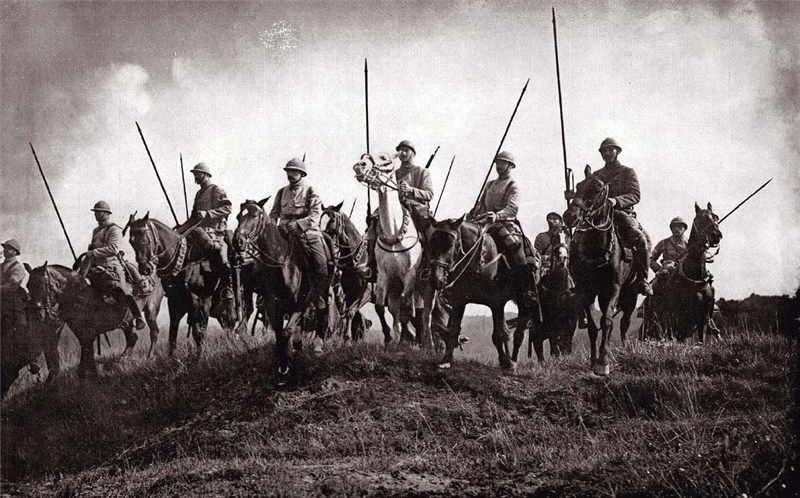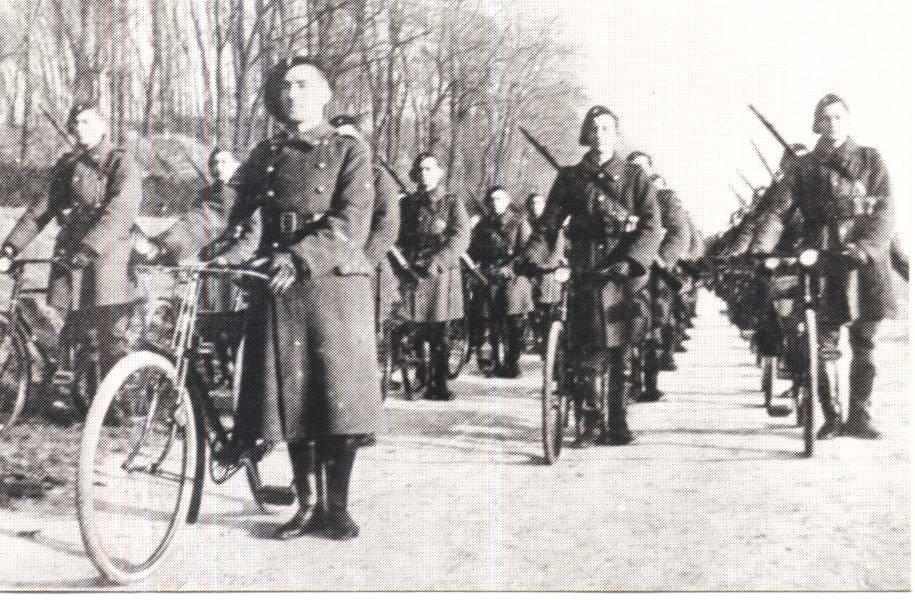| 1940: The Blitzkrieg Legend
Comparative War Planning, Part Two
By Vincent Kamer
February 2023
Much ink has flowed, and many calculators have melted down, in the debate over whether the Germans had superiority in numbers and in quality of material over the Allies. Images of plentiful Panzers and planes and massed troops, and soldiers jumping out of planes, once again spring to mind. And these are required, because it is accepted wisdom that on a level playing field a 3:1 advantage is generally needed by an attacker to overcome an equally competent defender.
Numbers are of course numbers, and they are well known and not disputed. There is no doubt when looking at total manpower the Allies had 151 divisions at their disposal to Germanys 135 – a 12% advantage to the Allies. Total armored vehicles are 4,204 for the Allies to 2,439 to the Germans – a 72% advantage to the Allies. Total planes come to 4,469 to the Allies and 3,578 to the Germans – a 24% advantage to the Allies. One starts to understand why most of the German General Staff was more than a bit alarmed when Hitler declared he was going to attack the Allies.

French cavalry would screen the Ninth Army's deployment..
These forces matter, but they matter most when they are in the right place per Clausewitz’s Schwerpunkt principle. If you start stripping out the forces which were in other theaters or in the frontier fortifications or in reserve, the picture starts to change. The Allies still have 66 divisions in the field vs Germany’s 57 – a 16% advantage to the Allies, but of those only four are Allied armored divisions against 10 German armored divisions for a 250% advantage to the Germans. In terms of pure numbers of armored vehicles, the difference is much less. This can be explained by the fact that nearly half of French armor was not grouped in large units, but in individual small independent tank battalions.
Planes available at the front on May 10th were 1,453 for the Allies vs 2,589 for the Germans – a 78% advantage to the Germans. Where did all the Allied planes go? It is a little-known fact that a huge number were kept in reserve to avoid them being knocked out in the first weeks of war and to replace losses in what was assumed to be a very long conflict. Others were just arriving in France as part of the French Air Force’s upgrade program: the timing of the German attack was in that sense perfect. According to Frieser the French fielded only a quarter of their total air potential in the first days of the offensive.
Looking at the situation in our case study, Kluge had a total of 12 divisions at his disposal. Ten of these were infantry (8th, 12th, 28th, 32nd, 62nd, 87th, 211st, 251st, 263rd, and 267th). The remaining two were armored (5th and 7th Panzer Divisions). These latter two were grouped into XV Motorized Corps under General Hermann Hoth, a respected panzer general, and formed the Schwerpunkt of the 4th Army. Hoth’s corps would be in the lead, starting across the Belgian border near St. Vith and aiming to cross the French border in and just north of Dinant. Fifth Panzer Division (the more powerful of the two) was led by the experienced General Max von Hartlieb, the 7th Panzer by a new up and coming general named Erwin Rommel.
André Corap’s Ninth Army had in total nine and a half divisions. Seven of them were also infantry: 18th, 22nd, 53rd, 61st DI (Division d’Infanterie), 4th DINA (Division d’Infanterie Nord-Africaine), 5th DIM (Division d’Infanterie Motorisée (motorized infantry) ) and 102nd DIF (Division d’Infanterie de Forteresse (non-mobile infantry)). The remainder were mixed motorized/cavalry divisions – 1st and 4th DLC (Division Légère de Cavalerie) and a cavalry brigade, the Moroccan 3rd BS (Brigade de Spahis). To support these divisions Corap had also three independent tank battalions in his Army reserve: 6th, 32nd, 33rd BCC. XI Corps d’Armée under Général Martin with two infantry divisions (18th and 22nd) was assigned the sector facing Dinant and somewhat to the north of the town.
It can also be argued that the French were in some way supported by the limited activity of the Belgian Army in the Ardennes – in front of the 9th Armée was the 1st DChA (Division des Chasseurs Ardennais) who were fighting on their home turf.

Belgium's elite - and well-dressed - cyclists are ready for war.
Getting out our calculator, this means the Allies were fielding 10.5 divisions against Germany’s 12 – a 14% advantage to the Germans. And the Allies had no armored divisions. They did have armored vehicles, in fact totaling up all those held by the BCC’s and DLC’s yield a significant 287. Even so, that’s much less than the 545 available to the 5th and 7th Panzer Divisions. Here the Germans had a huge 89% advantage. The numbers get even more dramatic when we get to the Schwerpunkt area. Here XI Corps has two divisions to XV Corps’s two, both of the latter armored. Even if we add in the two DLC’s covering the front of XI Corps, the ratio of armored vehicles is at best 96 vs 545 – a whopping 568% advantage to the Germans. At the same time during the first critical days 9th Army received NO air support save a few recon missions, while XV Corps got regular support and as of 14th May heavy support from the Luftwaffe. Suddenly those newsreels are starting to make sense again.
At least initially, however XV Motorized Corps was not able to make use of all those panzers. It had only a limited road net: as an example, on May 10th from Steinebrueck (starting point on the border) to Chabrehez (end point of the first day), 7th Panzer had basically only one road. There were simply not many roads and those that existed had been extensively mined, blocked and blown up by the Chasseurs Ardennais. It resorted to splitting up its forces and putting Vorausabteilung Steinkeller in front. Steinkeller led the motorcycle battalion, to which were added elements of the armored recon battalion, a battery of artillery, some engineers and a company of tanks – a force of some 700 men and 30 armored vehicles. Around 1700 these encountered the only position really defended by the Belgians of 3rd Company, 3rd Regiment Chasseurs Ardennais – less than 200 men with no artillery support , armored vehicles or anti tank guns, just the terrain and an anti-tank ditch. A firefight ensued in which the plucky Belgians held off Steinkeller until nightfall before being outflanked and overwhelmed, with most of the force retreating away. The handful of Chasseurs stopped the whole 7th Panzer Division for over four hours. This, among other things, caused a traffic jam stretching 150 kilometers all the way back to the division’s starting bases inside Germany.
Also remember that while not having armored vehicles was a disadvantage, the essential Allied mission was defensive. For this the Allied forces could also use anti-tank guns of which they had a reasonable amount: mostly 25mm which were effective enough, but also some excellent 47mm weapons. Ninth Army had an estimated 184 anti-tank guns. XI Corps with the two DLC’s in support had an estimated 140. As long as these could not be overrun, they formed a considerable danger, as Rommel could attest – the Panzer III he was riding in on May 13th got shot through with shrapnel scraping his cheek, a very near miss indeed.
Last but not least, XI Corps had the mother of all anti-tank ditches at its disposal: the Meuse River. At Dinant the Meuse is up to 100 meters wide with high cliffs along much of its length. As long as the bridges were blown, no tank could swim across. The defenders then had to deal with infantry trying to cross by all kinds of means, and these would be very vulnerable both during the crossing and, should they make it across, until they were properly reinforced and supplied.
So the forces present at critical parts of the front – especially in the crucial categories of armored vehicles and support planes – tilted the balance of success even more towards Germany. But even at this stage not all was lost, nor the outcome a foregone conclusion.
You can order 1940: The Fall of France right here.
You can order 1940: The Last Days of May right here.
You can order Road to Dunkirk right here.
Sign up for our newsletter right here. Your info will never be sold or transferred; we'll just use it to update you on new games and new offers.
Want to keep Daily Content free of third-party ads? You can send us some love (and cash) through this link right here.
|
